I’m allowed to like my own puns, right?
Noticed this neat photo of a seal perched on an unusually shaped open seashell, ornamenting a building somewhere downtown.
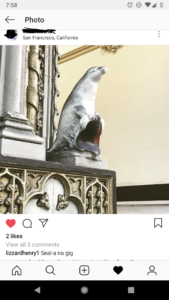
Comment: Seal-a-na-gig
Moments of coming up with the perfect reply should be recorded!
I’m allowed to like my own puns, right?
Noticed this neat photo of a seal perched on an unusually shaped open seashell, ornamenting a building somewhere downtown.

Comment: Seal-a-na-gig
Moments of coming up with the perfect reply should be recorded!
From a recommendation from my dad, I’m reading an actual paper book, Four Brothers in Blue, which is mostly letters from four brothers who were all in the Union army in the U.S. Civil War. They were in different regiments and wrote letters home & to each other. This was strung together many years later by one of the brothers with details (boringly) filled in.
The letters are mostly about details of the misery of soldier life: being cold, losing all your stuff or throwing it away on a long march while carrying 100 pounds on your back in 90 degree heat, needing more socks, mud, blisters, asthma, what it’s like to wake up with lice crawling all over you, eating disgusting food, and how the entire army has diarrhea as well as lice. Somehow, I always like reading this sort of book as it makes any physical pain I’m in less significant as I try to imagine having to walk several miles to gather hay and firewood to button into my lice-filled poncho in the freezing night, for warmth, as i attempt to sleep “on the soft side of the planks”.
Early on in the book and the war, the brothers are fans of McClellan, calling him “Little Mac” and reporting excitedly if he passed close by them on parade. He kept the army morale high, even if they did think he should have followed up quicker after Lee’s defeat at Antietam. They were disappointed that this hero wasn’t taller. One brother even sneaked up to McClellan’s horse, Dan Webster, snipped off a piece of the horse’s mane as a souvenir, and sent it to their mom. I guess this horse must have had a McClellan saddle.
The letters written back to them from their mother and father are missing but you can tell they were being sent little care packages of bandages and medicine by their mom, and stern advice about knapsacks from their dad. All the brothers explain repeatedly to their dad that his knapsacks sucked because they were heavy and the straps too narrow, and they can’t carry all that stuff because they have giant ammo pouches and 50 pounds worth of guns. They stick closest to their “rubber blanket” which I imagine to be a bit like a ridiculously heavy yoga mat, and anything made of wool though the blankets are the 2nd thing to go after the knapsacks. Ponchos sound the easiest to carry. So, now I know some survival tips, in case I’m accidentally transported back in time to 1861 as an able bodied 20 year old man. How useful!
It is very strange and mostly nice how everyone responded to our getting married! So glad that we ran off secretly so as to keep all that minimal.
Meanwhile, last night we read some very terrible poetry by that lawyer poet mayor of SF, which led us to try and find songs to sing his horrible sonnets to as we obsessed over the meter, and a particular poem about Andreé’s Pigeon which led us to get extremely obsessed with S. A. Andrée’s disastrous Arctic Balloon Expedition of 1897. Tonight after dinner and some excellent pastries and explaining everything about how our day went to each other, I showed off my complex bugzilla queries and Danny is explaining his AMAZING command line email system and fixing a bug in it while also showing me his Beeminder logs.
We are also planning our Vallejo honeymoon cruise since we miss marina life and would enjoy hanging out with the radioactive waste of old nuclear submarines and derelict buildings that are slowly gentrifying into breweries.
Just Danny, me, my cyborg steed bedecked with flowers, and a looming bust of Edward Robeson Taylor, lawyer and poet & mayor of San Francisco in a time of disaster and deep political corruption.
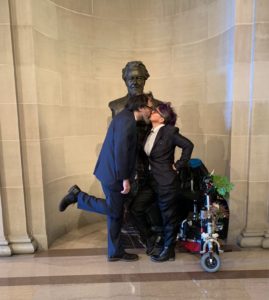
We had a lovely wedding at City Hall with my sister as witness and then went to hang out at the Cliff House and Land’s End.
It was fun to elope – we didn’t tell anyone except my sister and our kids, not until the last minute.
Looking forward to many more happy years together!
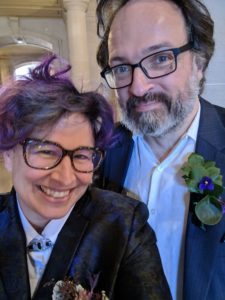 .
.
“San Francisco, O glorious city of our hearts that has been tried and not found wanting, go thou with like spirit to make the future thine.”
Sleepily flicking through Instagram this morning I got a glimpse of an amazing looking dance and had to look up the full video. I saw Loyalty Dance Team at the International Hip Hop Dance Fest in San Francisco a couple of years ago (doing their stunning 101 Dalmations number). This is their Black Panther – 6 and a half minutes of pure shining talent – Fantastic choreography!
Here’s their Instagram if you want to follow!
I am now feeling very energized!!
Bonus video because I LOVE BIG FREEDIA SO MUCH
Strange dreams of scootering down Valencia, not Valencia Street as it is now, but alternate-Valencia of around 30 years ago, out to do a quick errand, nearly but not quite picking up a nice brown striped scarf with fringe that was hanging over a bench (I figured that I should leave it for someone who needed it more). Everything was shut, and the streets were empty and ghostly in the middle of the night. The night had a wistful quality. Bright, moonlit, the iron gates with angular and scrolly shapes lit by soothing neon. I was happy to be there.
On my way to do this errand, I went up a side street, noticing that it was Elizabeth Street (which exists in the approximately correct location in the dream!) Elizabeth Street turned into mansions, difficult to navigate cobblestones, and ended in magnificent yet hostile giant flights of stairs going up the steep hillside. It was one of those wide multi-stage stairways meant to be monumental and beautiful, all in marble, spreading out over the hillside. I swore a lot & turned around.
I went back to the building where I was going to meet Danny to watch some scenes from a film be made (for a sequel to Superman where Superman was Jet Li, but in a powerchair). I had left this scene to do my errand and it was time to go back. There was no obvious way in, so I sneaked in via the back entrance and freight elevator, ending up in a back room, with people working, a tour group with badges coming through. I mingled successfully as if I had a right to be there, explored that level of the building, and found a second freight elevator to take me back to the film production studio. (Quite proud of sneaking back in successfully without fuss.)
In the studio as we sat in uncomfortable folding theater chairs, Danny explained things to me about what the film crew was doing. I was excited to see Jet Li. The people on stage kept trying to shoot a tiny part of one small scene where the actors were going down a hallway. I realized I was probably not going to see Jet Li do any sort of amazing martial arts from his powerchair because it was going to take all night to shoot the hallway scene.
It can be boring to read about other people’s dreams. They are so personal. Mine are often set in large rambling building complexes: 30 years after moving out of my housing co-op, I still get “like the co-op, but different” dreams. While I was walking pretty well for a few years I would still be using my wheelchair in dreams. I sometimes dream in Spanish, and I can read and write in my dreams. I’ve written stories and poems while on the verge of waking up and then quickly scribbled them in real life. And while I’ve been 99% using scooters since 2012, I still dream myself in my manual chair much more often. It still has a more “me” feeling sometimes. But this was a scooter dream!
The things that happen in my dreams feel like memories, not real memories, but like real feelings. They are atmospheric. If I dream of a completely non-existent person, I feel sad when I wake up that they don’t exist, but also amazed that our minds can come up with an impression of an entire human being. Dreaming of Alternate Not Quite Valencia Street gave me a specially happy and centered feeling this morning.
Random encounter: On the 49 bus yesterday I explained my scooter to a woman who was very interested in one for herself. Then had to start over but this time in Spanish for another woman and then the first one began translating for someone who spoke Mandarin. 5 people took cards with the name of the scooter on it (at least…. I may have lost count). Somewhere between 24th St. and 14th St. I finally just took the whole scooter apart, folded it up, passed around the lithium battery, then put it back together (by request). “FREE SHOW Y’ALL!!!”
The first lady (the Chinese translator) nearly got off the bus with me to try it. She had opinions on reupholstering, making it easier to fold, a better cup holder, my decorations, the good qualities of the little bell on my handlebars (which she kept reaching over to ring, looking at me and giggling)
It was a little bit emotionally exhausting and I missed my usual Ingress hacking/Pokémon catching fun for the bus ride but it was also super fun. We had good cameraderie going in the front section of the bus.
If everyone I talk with about mobility scooters gets one, none of us are gonna be able to fit on the bus 😀 They will need more and better buses, that’s all!
This week I’ve left the house every day. Something to celebrate as I’ve spent a couple of months at home. Saturday, I was SO excited to go to the DIS2018 Bay Area event.
Danny and I took the bus and BART over to the Ed Roberts Center. This was nice in itself for me because I like taking trains – and at the BART station plaza we caught a few songs from the Cuban music group Orquestra de 24. It was hard to tear away from that, but they are there every Saturday. The crowd there was having a lot of fun.
On to describe the event and then some of my thoughts about it!
The Disability & Intersectionality Summit (DIS) is a biennial one-day conference that centers the experiences and knowledge of multiply marginalized disabled people such as, queer disabled people of color, undocumented transgender disabled people, or formerly incarcerated disabled people among others. This conference serves as a platform to highlight the multiple oppressions that shape the lived experiences of disabled individuals, as told by disabled people, in a setting organized by disabled activists. DIS aims to create dialogue on how our society must address systemic oppressions using an intersectional approach.
I missed the morning keynote by Mia Mingus but will watch it later on video. (her talk starts about 21:45)
Makers Faire: I only had a few minutes for this, but I bought stickers and zines from Danchan – beautiful, cute, healing. The messages conveyed by her art are in a way something I have been feeling the lack of, so I was instantly just so happy – this is hard to express. Some of the Stay Home Club things give me a similar feeling but these hit the spot more exactly – to encourage & celebrate love and care from this particular perspective. That it is a radical act to care for ourselves and each other. “Vulnerability” – a person in a hoodie holding their arms in the air with a rainbow above; “Hold Each Other Gently” – hands cupped underneath a box wrapped with caution tape; “Stay Loving Stay Angry” with a dagger through a heart. I also liked (and bought) a flag with a blockprint of a powerchair and “SMASH THE FASH” from FatLibInk folks, and some small prints from Mchhim (I can’t find their info but a sticker that says Your Luxury Is Our Displacement and a flower with the roots exposed).
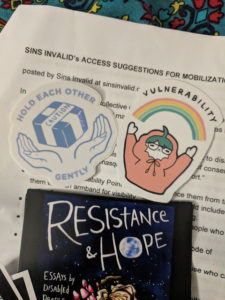
At another table I picked up a flyer of Sins Invalid’s Access Suggestions for Mobilizations. Sins Invalid also has a very good Access Suggestions for Public Events. I recommend them both. Maybe your organization or event can’t manage all of these things, but the ones you can, you can explicitly SAY that you are planning to provide, in your event information, invites, announcements, and so on. Making that information easy to find, ahead of time, is an important part of access and inclusivity. At least, by providing the info, you’re signaling very clearly, Less Bullshit Than Usual maybe and that you have thought about & worked towards access. The detailed, granular information you provide is part of the accessibility! Basically when I see simply “Wheelchair accessible venue” on an event description, that’s nice, but one, I can never believe it, and two, it doesn’t describe what I need to know.
I also picked up a beautiful postcard with the cover art for Alice Wong’s upcoming anthology, Resistance and Hope: Essays by Disabled People. “Crip wisdom for the people.
The first afternoon talk was Resistance & Hope: a dialogue Alice Wong & Stacey Milbern – moderated by Robin (@sexabled). While I was kinda hoping for one sort of discussion, we got another, just as good or better.
Alice opened by describing her fear, pain, and anger from the 2016 elections, and how she reacted by wondering what she could do best to foster resistance and hope. Her work for the Disability Visibility Project & for this anthology to be a source of hope in creativity.
Stacey then talked about finding hope in the midst of despair; part of that is in the imagination, imagining and creating ways for us as disabled people to lead resistance. Specifically, for queer/trans/POC disabled folks to lead. For example, within disability activism and communities, we can imagine, what if this movement was led by people with intellectual disabilities, people with mental illness? Once we imagine that, we expand the boundaries of what is possible.
Alice mentioned something I deeply believe, that the people at the margins know the systems they’re in the best. (An idea I first began to understand from Gloria Anzaldua, in the 80s.) In daily lives, we have to fight and resist for so many things, so that something like having plastic straws or riding public transport is part of our resistance. We are struggling to be in public space, as part of our survival.
I appreciated the fun moment where Stacey described Alice as “futuristic”. She said that you can see organizations, non profits, and so on, scrambling to figure out how to use social media. Alice creating the Disability Visibility Project is a good example of using technology effectively – that’s the futuristicness. (Or, think of her with the telepresence robot at the White House!) Consider, from the constraints under which you operate (this is me not Stacey) what you then make happen. To me, that’s part of what it can mean to lead from the margins and why it can be effective. As an important part of that concept, we must challenge the presumed whiteness of disability be centering people of color in the disability justice movement.
Alice responded to Stacey’s talk of being futuristic by saying she likes to think of herself as an alien cyborg. (Darth Vader is a much misunderstood disabled character.)
I hooted appreciatively. Ah, I love them both! And us all! Me too! Cyborg & proud! Alien love! Science fiction is a revolutionary force! Queer feminist cyborg power!! *Explodes from enthusiasm*
Stacey and Alice then turned the discussion to ask the rest of us in the room, What do you resist here in the SF Bay Area? What gives you hope and strength?
I did not always catch who was speaking but did hear, among other things,
* Lily talked about doing the work to create a beloved community
* Brotherhood with neurodivergent men of color who are living on the street, as good resistance work
* Monique talking about struggling with inaccessible bathrooms in the Bay Area and also, that people underestimate the intelligence of others in centers ie, in institutions
* rent
* inaccessible parking
* white supremacy and patriarchy
* categories and labels that block connection to humanity
* ableist public schools
* Sanjay says he resists people who grab him and pray on him in the street and, when ppl say they’re ignorant about disability but they all know someone disabled, they just aren’t listening to or paying attention to their own friends and family
* Reactivity, anger and argumentativeness from someone who says she is trying to educate more patiently on a daily basis
* Academic elitism and snobbery
* Gigi talks about pee in the broken BART elevators and her desire to travel the world. Airlines break our chairs so it’s too risky. Technology and social media give her hope, keep taking pics, report, fight, share.
* Lateef (https://twitter.com/kut2smooth) spoke briefly and passionately about the damage done to us. While I didn’t capture it precisely I had the impression that he had plenty to say that I want to hear. So asked him afterwards for his info – I now see from Lateef’s site that he is a poet too. Poets know! You can buy his book, A Declaration of A Body of Love Poetry – I just did.
I liked how Stacey, Alice, and Robin, Allie taking the mic around, and others, made that space for many people to speak and be heard by everyone in the room. All too brief. Claire made the point at the conference’s closing that this is just a glimpse of each other and we can work over the times to come to make sure we keep in touch and nurture the new connections we’ve made.
Along with others at the DIS2018 Bay Area gathering at the Ed Roberts Center I then watched the closing keynote by Anita Cameron via video streaming from the national event. Anita gave a broad overview of her 33 years working with ADAPT. Kinda 33 years winding up to “How do I bring my full self to this fight?” including blackness, being a woman, a lesbian, all my experiences and identities and anger, to the disability justice movement? The “how” is a long answer too long for a talk. It’s ongoing work, it’s more than having a couple of meetings. It was Mike Brown’s horrible murder in Ferguson that sparked Anita’s re-evaluation of her engagement in ADAPT.
I was thinking from that and previous discussion how hard it is to capture the complexities of these answers. Past the basics, what do we actually do? It is a process of gaining wisdom and experience. We can indicate some ways and truths. We can say things that might sound simple, but hold a world of meaning for your thoughts and actions to explore. Expecting a full explanation in this context is like wanting the content of a person’s life to be poured into your brain. (If only!) This is why we have conversations over time, and novels, and movies, it’s why we have stories, because stories are one of the tools, the main tool, we have for this purpose.
Supporting POC-led events and organizations is super important. For me, it is the logical thing to do. It is often impossible to move an existing organization, or, not impossible, but it is definitely never INSTANT, it’s a long term process. There are many inherent pitfalls in that process (like for example tokenizing people). Personally I will never (again – I did at least once) start an organization run by only or even mostly white people, it just does not work for me, it is too flawed, and I don’t like how that unfolds. At best I think once that happens you can partner with other orgs, in a support role.
While I mention POC led organizations let’s name one, I recall someone referring to it and to Talila Lewis on stage yesterday but not exactly what they said. You might have a look at HEARD. A good organization to support. As you may know, when police in this country kill people, over half of their victims are disabled and they are disproportionately disabled people of color. The violence of the prison system is a perpetual horror and we have to fight it on every level.
Helping Educate to Advance the Rights of the Deaf (HEARD), is an all-volunteer nonprofit organization that promotes equal access to legal system for individuals who are deaf and for people with disabilities. HEARD primarily focuses on correcting and preventing deaf wrongful convictions, ending deaf prisoner abuse, decreasing recidivism rates for deaf returned citizens, and on increasing representation of the deaf in the justice, legal and corrections professions. HEARD created and maintains the only national database of deaf, hard of hearing and deaf-blind detainees & prisoners.
On holding space open. While I appreciated aspects of everything people said in the “discussion” part of the afternoon, I also think white folks might stand to listen more, and help to hold space more, rather than taking that space. We all need space to speak. Do I have plenty to say on these subjects? Yes obviously, LOL. Did I need to speak in that process, no I did not. I have massive privilege and opportunity to say what I have to say. That time is better spent literally listening to whatever the people have to say who have the most difficulty. Even that one weird motherfucker who went on about his spiritual wife. OK man we’re holding space for you to be your own glorious weird-ass self. That is also what it is for. Now, I’m sure everyone has their struggles and maybe it is particularly important to hear from Brother Berkeley McWhiterpants about his allyship in the very middle of an event centered on and run by people of color but…. Come ON. (end mild rant)
So I am left with the thoughts of the concrete actions I am taking (and that I support others in doing) For me a part of that is to look around me for people to connect with in my neighborhood. I talk about mobility issues and other struggles with people I just run into. And, I try to balance my financial support between organizations and individuals, who I know and who are strangers to me (which I think is important, as if you only share resources with the people you are already friends with, that just keeps whatever systemic patterns exist in their same patterns.
The structure of the event at the Ed Roberts Center was interesting in itself.
The stage too was a nice thing, though I would have liked it to be a bit higher, it had a broad ramp integrated with it so that it wasn’t a tedious process for folks to get on and off the stage.
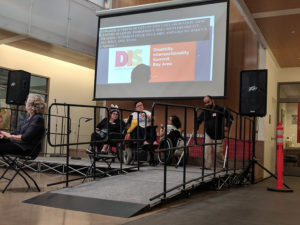
I liked the MC-ing by Gigi and Claire Light. Claire led some moments of pausing and breathing, something I’m not great at doing, especially in public (because it means listening to my pain instead of blocking it out, and I don’t want to cry or whatever), but I think it was a good thing for many people in the event and a good idea to make space to ground ourselves. There was also a quiet room available. Towards the end of the afternoon I just got on the floor against a wall and laid down to listen and felt zero worry about other people’s opinions of that. (Something I’ve often done when I’m just that much in pain and tired, but don’t want to go home, I’d rather be able to participate, but others are uncomfortable or it breaks various social rules, and yes that’s why some folks have reclining wheelchairs or maybe I’d be better off staying home but, I can get up and down off the floor and it’s RIGHT THERE.)
I immediately had a wild surge of happiness at being in a crowd, without being crowded and trapped. The space itself was arranged in an open way, with tables spaced widely, and plenty of flexible area for use. Within that space and on the nice smooth floors, others were zipping about, I could hear their motors or appreciate the visual nearly silent, quick motion as they (we) rolled around the room. It was like the pleasure of watching swallows in flight. I thought of specific moments like being at Hamilton Pool near Austin, a limestone sinkhole over a large pool of water, with hollowed out, round cliffs, the mud swallow nests clinging to the cliffs 70 feet overhead and the birds darting in complimentary shapes to the arc of the inverted bowl, not acting together as a flock or a swarm, but each in pursuit of their own invisible goals. (Bugs.) Often, in a crowd, like at a conference hall or hotel, I zip around and, especially if the floor is smooth, I feel something of that pleasure of motion. It means having to be mindful of others in a particular way, that ideally includes my modeling of their ability to predict my motion and trust that I am competent. So, it is rare for me to be in a space like that and feel real joy in motion – It has to be open enough and non chaotic enough to allow for our normal motion not to scare people (whether they have good reason or not to startle and freeze or even leap away, as they do). Maybe the Dyke March and its attempts to hold space open between the main banner and the trolley and sound truck for wheelchair users. What I’m winding up to is that I’m often the only wheelybot in group spaces, so it was a specifically embodied pleasure to be not the only one but more than that, to feel so beautifully comfortable in my own erratic orbits alongside others zooming around. It filled me with joy.
Saw so many friends, met new people, haven’t been so excited about being at a conference in a while.
And, final plug for the Disability Visibility Project. Podcasts, a stream of excellent Facebook posts, Twitter chats on #CripTheVote, #CripLit and other topics. Add them right now to your social media of choice and follow along – you will be sure to learn something & have your world expanded.
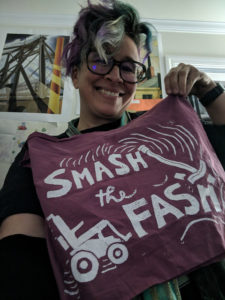
An interview with Jaron Lanier, https://lareviewofbooks.org/article/delete-your-account-a-conversation-with-jaron-lanier/#!
So the problem is that when people say, “Oh, we use social media for social justice,” they’re typically correct. And yet in the longer story they’re really vulnerable to a far greater backlash than they would have gotten if they used another technique. At the end of the day, it’s hard to say whether they really benefited or not.
I disagree with what Lanier seems to be trying to say here. Of course if your activism reaches more people you are going to get more backlash. Are the specific people advocating for change ever going to be the ones to personally benefit for that change? Rare!
What they want to do is take whatever input people put into the system and find a way to turn it into the most engagement possible. And the most engagement comes from the startle emotions, like fear and anger and jealousy, because they tend to rise the fastest and then subside the slowest in people, and the algorithms are measuring people very rapidly, so they tend to pick up and amplify startle emotions over slower emotions like the building of trust or affection.
Interesting, and makes me think of Stardew Valley and its slow building of relationships between the player-character and the NPCs, relationships that have to be maintained. I also thought of the first example I was aware of, of the seemingly pointless exchange of tokens of approval in a social network, which I think was my friend Yoz creating something called “Sweeties” in Ning. And tangentially, of all the feminist sf utopias where there are barter based economies. Build in and opting into “slower” economies of attention could be possible – Excuse me while I go invent actual real life friendship, and the postal system – But seriously, I like this point and the only real answer to it may be to point this out to folks and for us all to seriously think about how we want to spend our time.
I am also thinking of my essay on culture clashes and the underlying assumptions of the trolls of the 00s with particular feminist communities. One assumes that showing that you are harmed is evidence you need to be harmed more in order to do you the favor of toughening you up. The other values its “hugbox” (a term used as a pejorative by the trolls) ie, its social contract to be supportive, kind, and to value the courage of vulnerability.
There is something to thinking “well, we SHOULD be alarmed and upset” about how things are – I think that is mistaking the early or middle phases of consciousness raising for a desirable steady state of being. It is normal in my view to have something of a breakdown as we try to integrate awareness of our participation in harmful, terrible or evil events and systems. As we see these truths we have to form some kind of narrative about what is happening and what we’re doing. That is where we’re at right now in public discourse – we are in a phase of rolling chaos and dis-integration.
Another article: This particle physics news was neat to see, as my ex partner used to work on these sorts of experiments (including AMANDA, the precursor to Ice Cube).
There is an open call for submissions to Cripple Punk Zine:
Our goal is to continue spreading radical disability acceptance to as many people as we can. We want to help raise disabled people’s self worth and self esteem, support disabled content creators, and create more spaces for disabled people to unapologetically be themselves. Every single disabled person deserves to feel empowered!
We are currently accepting submissions for the first issue, which will answer the question, “What is Cripple Punk?” and what cripple punk means to different people. The first issue should cover topics central to the cripple punk movement, like fighting ableism, embracing diversity, becoming empowered, and rejecting the roles mainstream society expects you to fit into.
I may write something and send it on.
I enjoyed this essay by Harry Giles (a rec from Sumana) on nurturing vs. shock in performance art.
Learning how to care for your audience is actually far more aesthetically interesting and politically disruptive than working out how to shock them.
This fits well with reading Lanier’s interview.
On shock and harm in art:
In each of these works, it is clear the people are actively harmed by the art, and this raises vital artistic and political questions. Who is it that is harmed, and why? Is it worth it? In Pussy Riot’s case, the punk gig offends worshippers and people who believe in a certain sanctity of the church space, who feel violated, but I would argue that in this case the violence is justified in the cause of attacking a patriarchy whose foundations rest in part on that very sanctity. But these are not easy arguments to make, and they are not artworks that I think can be taken or performed lightly.
I thought of myself and some of the activism I have done, for example, times I have been naked for a cause. Was my going shirtless at riot grrrl concerts or stripping down for a picture for body positivity with Nakedjen in various places a positive, transgressive act, or a rude, offensive, illegal, non consensual violation of other people’s space that possibly harmed someone? Is it different from Kavanaugh flashing Ramirez at a frat party and if so, how? My view here is that the potential harm is important to acknowledge, and that the expression, intention, exuberant joy, humor, etc. was worth the risk, and the context has to be considered.
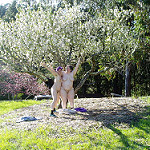
Random encounter on the bus yesterday on the way home. The bus was a little crowded, enough that I thought the bus driver might not let us on, but he started to lower the lift for me and to ask some folks to move back. As he did, an older woman with a walker came up and I fell back a bit to let her get on first (on the theory that I am sitting down, she is standing up, let her get settled). She nodded at me in a very definitive way as if to say, “CORRECT”.
But the bus driver even more correctly said, No, wheelchair first, and I realized that if the lady with the walker got on first I would not be able to go past her easily to get into the wheely spot because of the particular configuration of the bus, so I got on first (with some attempt at conciliating explanation ) As I settled into a seat and pulled my scooter into the little open slot next to it I realized I should save the empty seat next to me for her because she was very short and the other open seat near the front was the kind over the wheel well that is a few inches higher (too high for my feet to reach the ground if I sat there) So I stopped a middle school kid from sitting next to me. Walker lady saw this with a keen eye and sat with me triumphantly. Ada came to stand behind my scooter with her back against the upturned seats, messing with her phone.
We smiled at each other a lot. She then pointed out that my red flowers on my scooter matched her red walker and jacket. I agreed and said I like bright things. “This is from Guatemala (her bag), This is from Mexico (her brightly flowered huipil) This is from Peru (her woollen striped headband) And me, from Mexico” I admired her colorful ornamentation and said where I was intending to get off. She was going to play bingo at the church on Cortland. I told her about the free tai chi classes at the neighborhood center across the street.
During the bus ride every time someone new got on she quickly assessed the seating situation and decided where the new people should go. And she made it happen with very little English – and perfect confidence – in fact we both conspired (in a way hard to describe but which meant we had to both indicate with body language that people were welcome to go past us or that we could slightly move our machinery around and back again). Her bus-packing logic was impeccable, factoring in frailty, youth, and encumberment.
On this bus, I generally get off at 30th Street because it’s a more major stop than the one a bit closer to my house, and more people get on and off there. If I wait for the closer stop, then the bus fills up and I have to make my wheely way past many people’s toes, so it’s better to leave during the period of greater churn. I would have liked to explain my reasoning to the maestra of bus loading but instead wished her luck at bingo.
“Do you see that lady a lot?” Ada asked me once we were on the sidewalk. No — I just somehow loved her instantly because she was so cheery, and also because she was super into figuring out bus seating optimization. 😀 That’s my story…. It is uneventful – but I enjoyed the entire thing.
Also! That was a particularly decent bus driver to let us both on without fuss and I intend to compliment him through the 311 system.